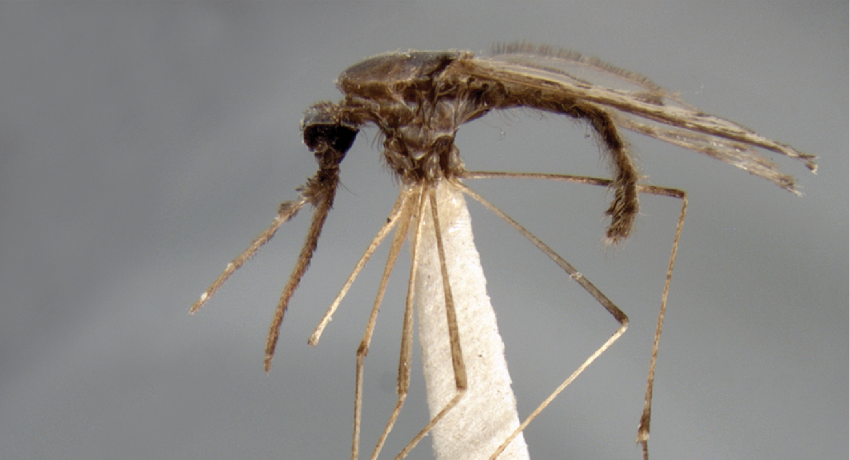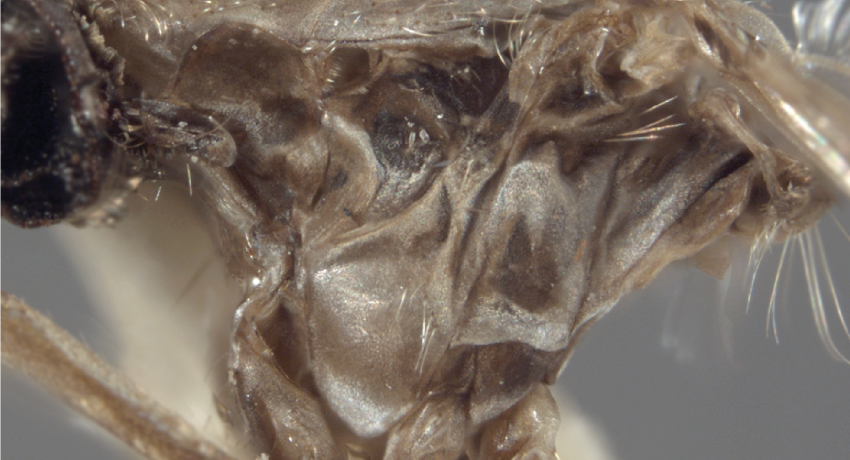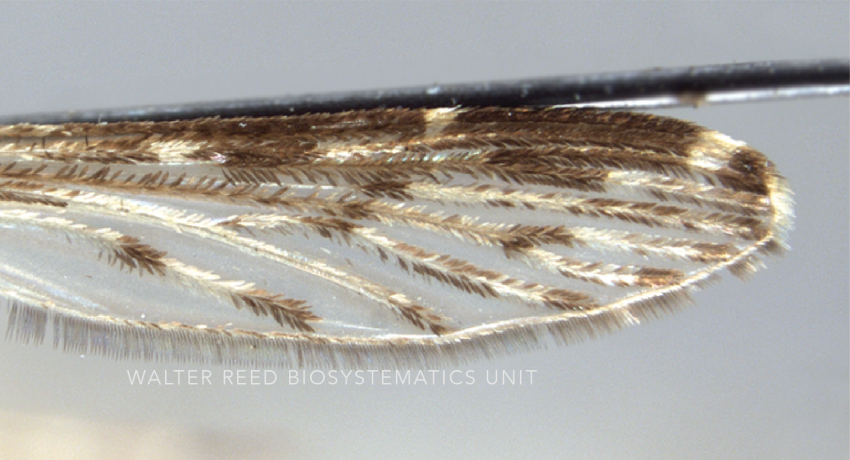INDO-ORIENTAL REGION
Etymology: blackest (L)
Anopheles nigerrimus is a large, dark mosquito belonging to the Nigerrimus Subgroup of the Hyrcanus Group, an assemblage of 25 species, many of which are major malaria vectors. The Nigerrimus Subgroup also includes An. nitidus Harrison, Scanlon & Reid, An. pseudosinensis Baisas, and An. pursati Laveran. Anopheles nigerrimus has five current synonyms: indiensis Theobald, bentleyi Bentley, minutus Theobald, williamsoni Baisas & Hu and venhuisi Bonne-Webster.
Type locality: Calcutta, [West Bengal], India
Type depository: Natural History Museum, London, England, United Kingdom (NHMUK)
DIAGNOSTIC CHARACTERS (Click photos to view; mouse over and click large photo to zoom in.)
ADULT (illustrated): Head: Basal 4-8 flagellomeres of flagellum (Fl) with pale scales; clypeus (Clp) with lateral patch of dark scales. Thorax: Antepronotal scales present. Wing: Costa (C) without presector pale spot. Legs: Without tuft of dark scales; Fe-III without distal broad preapical white band; Ta-III1–5 with basal and apical pale bands. Abdomen:
LARVA (not illustrated): Head: Seta 3-C 40+ branches, branched from near base. Thorax: Seta 1-P without branches on basal 0.5, single or with short branches on distal half. Abdominal segments: Seta 1 well-developed palmate on ≥5 segments.
TAXONOMIC KEYS
Nguyen Thuong Hien 1968
Rattanarithikul & Harrison 1973
Lee et al. 1987b
Rattanarithikul et al. 2006b
![]()
WRBU – Anopheles - Myzorhynchus Series - Indomalayan Region - Adult
![]()
WRBU – Anopheles - Myzorhynchus Series - Indomalayan Region - Larva
![]()
WRBU – Anopheles - Myzorhynchus Series - Oriental Region - Adult
![]()
WRBU – Anopheles - Myzorhynchus Series - Oriental Region - Larva
![]()
WRBU - Anopheles - Western Palearctic Region - Adult
![]()
WRBU - Genera - Global - Adult
![]()
WRBU - Genera - Global - Larva
![]()
WRBU - Genera - Indomalaya - Adult
![]()
WRBU - Genera - Indomalaya - Larva
![]()
WRBU - Genera - Oriental - Adult
![]()
WRBU - Genera - Oriental - Larva
![]()
WRBU - Anopheles Subgenera and Series - Indomalaya - Adult
![]()
WRBU - Anopheles Subgenera and Series - Indomalaya - Larva
![]()
WRBU - Anopheles Subgenera and Series - Oriental - Adult
Exemplar DNA sequences
An. nigerrimus COI: AB778787–99, AB781757–61, LC33324
BIONOMICS
Immatures
In mainland SE Asia, immature An. nigerrimus are found in deep, cooler freshwater sites, usually heavily shaded with dense aquatic vegetation, including large open marshes, large stream pools, and in fish ponds with plentiful water lettuce (Pistia stratiotes). The species raises in swampy rice fields and deep swamps with copious aquatic vegetation including Azolla, Eichhornia, Jussiaea, Hydrilla, Pistia and Spirodella in In Java and Celebes. In Sri Lanka, larval sites include agricultural and earth wells, borrow pits, rock pools and tank margins.
Adults
Biting females are most active just after dusk (18:00–20:00), and are attracted to both cattle and man. The species is a competent malaria vector in Bangladesh, Pakistan, Celebes, Java, Malaysia, and in the rice areas of southern Thailand, but has not been found naturally infected in India. Anopheles nigerrimus are common in lowlands and river valleys. Due to its association with intensive rice agriculture, evidence for insecticide resistance has been reported in this species.
DISTRIBUTION NOTES
Bangladesh, Brunei, Cambodia, India, Indonesia (includes Kalimantan), Indonesia, Malaysia (includes Sabah, Sarawak), Myanmar, Nepal, Pakistan, People's Republic of China (includes Hainan & Hong Kong), Philippines, Sri Lanka, Thailand, Timor, Vietnam.

WRBU VECTOR HAZARD REPORTS
None; View other WRBU Vector Hazard Reports
Available GIS Models:
IMPORTANT REFERENCES (full citations below)
Giles 1900a: 162 (F*)
Baisas 1947b (1st instar L; as hyrcanus subspecies nigerrimus)
Reid 1953: 24 (M*, F*, P*, L*, E*; to species)
Nguyen Thuong Hien 1968 (F*, L*; keys, taxonomy, bionomics, Vietnam, also as indiensis)
Reid 1968: 98 (M*, F*, P*, L*, E*; as indiensis)
Seetharam & Chowdaiah 1971: 429 (chromosomes*)
Aslamkhan 1971b (distribution; Pakistan)
Ameen & Talukdar 1974c: 91 (P*)
Harrison & Scanlon 1975: 65 (M*, F*, P*, L*; distribution)
Rattanarithikul & Harrison 1973 (L; key, distribution; Thailand; as indiensis)
Lee et al. 1987b: 67 (F key, taxonomy, bionomics, distribution, review)
Darsie & Pradhan 1990: 71 (distribution)
Glick 1992: 129 (distribution)
Linley et al. 1995: 54 (E*)
Whelan & Hapgood 2000 (bionomics, distribution; East Timor)
Oo et al. 2004 (distribution; Myanmar)
Rattanarithikul et al. 2006b (F*, L*; bionomics, distribution, keys)
Qu & Zhu 2008 (distribution; People's Republic of China)
Songsawatkiat et al. 2013 (molecular taxonomy; sensu lato)
Saeung et al. 2014 (E*)
CURRENT SYNONYMS
syn. indiensis Theobald
1901a: 145 (A*; sinensis subspecies). Type locality: Madras, India (NE). References: Harrison et al. 1973: 265 (to syn.); Townsend 1990: 86 (type information).
syn. bentleyi Bentley
1902: 15 (F*). Type locality: Tezpur, Assam, India (LU).
syn. minutus Theobald
1903a: 91 (F; Myzorhynchus, not Macquart, 1834). Type locality: Lahore, Punjab, [Pakistan] (NHMUK). References: Reid 1953: 51 (taxonomy).
syn. williamsoni Baisas & Hu
1936: 222 (P*, L*; hyrcanus var.). Type locality: Penang, Malaya [Malaysia] (NE). References: Reid 1953: 27 (taxonomy, ?synonymy).
syn. venhuisi Bonne-Wepster
1951a: 284 (M*, P*, L*, E). Type locality: Java [Indonesia] (LU). References: Bonne-Wepster & Swellengrebel 1953: 242 (A, L; taxonomy); Reid 1953: 24 (synonymy).
CURRENT SUBSPECIES
None
CITED REFERENCES
Ameen, M.-U., & Talukdar, M.Z.I. (1974c). Pupal chaetotaxy of the common mosquitoes of Dacca. Beiträge zur Entomologie, 24(1,4), 87–95.
Aslamkhan, M. (1971b). The mosquitoes of Pakistan I. A checklist. Mosquito Systematics, 3(4), 147–159.
Baisas, F. E. (1947b). Notes on Philippine mosquitoes. XIV. The larval instars of Anopheles. Monthly Bulletin of the Bureau of Health, 23(3), 197–207.
Baisas, F. E., & Hu, S. M. K. (1936). Anopheles hyrcanus var. sinensis of the Philippines and certain parts of China, with some comments on Anopheles hyrcanus var. nigerrimus of the Philippines. Monthly Bulletin of the Bureau of Health, 16(6), 205–242.
Bentley, C.A. (1902). Anopheles mosquitoes in Tezpur, Assam. Indian Medical Gazette, 37(1), 15–16.
Bonne-Wepster, J. (1951a). Anopheles venhuisi n. sp. Documenta Neerlandica et Indonesica de Morbis Tropicis, 3, 284.
Bonne-Wepster, J., & Swellengrebel, N.H. (1953). The anopheline mosquitoes of the Indo-Australian Region. Amsterdam: J. H. de Bussy.
Darsie, R.F., Jr., & Pradhan, S.P. (1990). The mosquitoes of Nepal: Their identification, distribution and biology. Mosquito Systematics, 22(2), 69–130.
Giles, G. M. (1900a). A handbook of the gnats or mosquitoes giving the anatomy and life history of the Culicidae. J Bale and Sons and Danielsson, Ltd London.
Glick, J.I. (1992). Illustrated key to the female Anopheles of southwestern Asia and Egypt (Diptera: Culicidae). Mosquito Systematics, 24(2), 125–153.
Harrison, B.A., & Rattanarithikul, R. (1973). Comparative morphology of the early larval instars of Aedes aegypti and A. seatoi in Thailand. Mosquito Systematics, 5(4), 280–294.
Harrison, B.A., & Scanlon, J.E. (1975). Medical entomology studies-II. The subgenus Anopheles in Thailand (Diptera: Culicidae). Contributions of the American Entomological Institute, 12(1), iv + 1–307.
Lee, D.J., Hicks, M.M., Griffiths, M., Debenham, M.L., Bryan, J.H., Russell, R.C., . . . Marks, E.N. (1987b). The Culicidae of the Australasian region. Volume 5. Commonwealth Department of Health, School of Public Health and Tropical Medicine Monograph Series, 2.
Linley, J.R., Yap, H.H., & Damar, T.B. (1995). The eggs of four species of the Anopheles hyrcanus group in Malaysia (Diptera: Culicidae). Mosquito Systematics, 27(1), 43–71.
Oo, T.T., Storch, V., & Becker, N. (2004). Review of the Anopheles mosquitoes of Myanmar. Journal of Vector Ecology, 29(1), 21–40.
Qu, F., & Zhu, H. (2008). On a checklist of the Anopheline mosquitoes in China with rectification for some specific names. Chinese Journal of Parasitology and Parasitic Diseases, 26(3), 210–216.
Rattanarithikul, R., & Harrison, B.A. (1973). An illustrated key to the Anopheles larvae of Thailand. U S Army Medical Component, SEATO, Bangkok, Thailand.
Rattanarithikul, R., Harrison, B.A., Harbach, R.E., Panthusiri, P., & Coleman, R.E. (2006b). Illustrated keys to the mosquitoes of Thailand. IV. Anopheles. Southeast Asian Journal of Tropical Medicine and Public Health, 128(Supplement 2), 2.
Reid, J.A. (1953). The Anopheles hyrcanus group in south-east Asia. (Diptera: Culicidae). Bulletin of Entomological Research, 44, 5–76.
Reid, J.A. (1968). Anopheline mosquitoes of Malaya and Borneo. Studies from the Institute for Medical Research Malaysia, 31, 1–520.
Saeung, A., Baimai, V., Thongsahuan, S., Otsuka, Y., Srisuka, W., Taai, K., . . . Choochote, W. (2014). Cytogenetic, cross-mating and molecular evidence of four cytological races of Anopheles crawfordi (Diptera: Culicidae) in Thailand and Cambodia. Comptes Rendus Biologies, 337(11), 625–634.
Songsawatkiat, S., Baimai, V., Saeung, A., Thongsahuan, S., Otsuka, Y., Srisuka, W., & Choochote, W. (2013). Cytogenetic, hybridization and molecular evidence of four cytological forms of Anopheles nigerrimus (Hyrcanus Group) in Thailand and Cambodia. Journal of Vector Ecology, 38(2), 266–276.
Theobald, F.V. (1901a). A monograph of the Culicidae or mosquitoes (Vol. 1). London: British Museum (Natural History). 424pp
Theobald, F.V. (1903a). A monograph of the Culicidae of the World (Vol. 3). London: British Museum (Natural History). 359pp
Townsend, B.C. (1990). A catalogue of the types of bloodsucking flies. Culicidae. Occasional Papers of the Natural History Museum (London)(7), 35–152.
Whelan, P., & Hapgood, G. (2000). A mosquito survey of Dili, East Timor, and implications for disease control. Arbovirus Research in Australia, 8, 405–416.
CITE THIS PAGE
Walter Reed Biosystematics Unit (Year). Anopheles nigerrimus species page. Walter Reed Biosystematics Unit Website, http://wrbu.si.edu/vectorspecies/mosquitoes/nigerrimus, accessed on [date (e.g. 03 February 2020) when you last viewed the site].










































































































































































